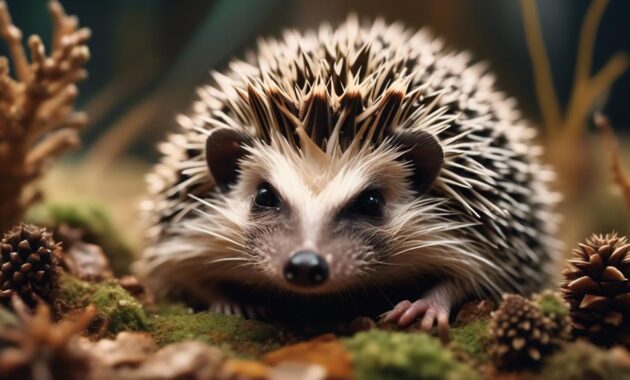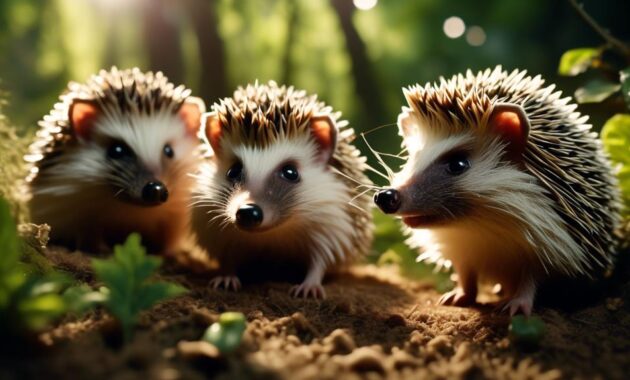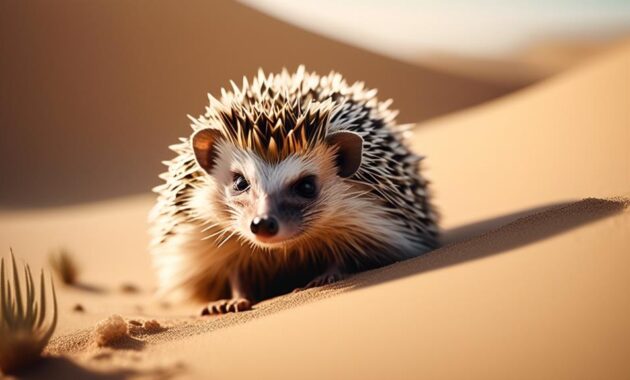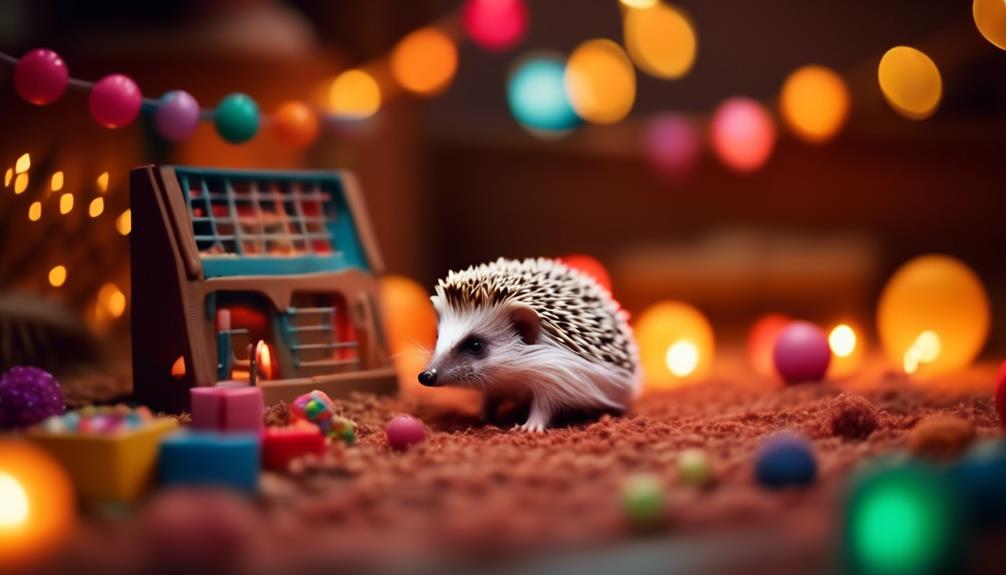
In recent years, there has been a surge of interest in the captivating world of African Pygmy Hedgehogs as pets. These enchanting creatures, hailing from Europe, Asia, and Africa, have made their way into the hearts and homes of people around the globe.
With their unique physical characteristics and intriguing behavior, it’s no wonder that African Pygmy Hedgehogs have taken the world by storm. But what exactly makes them so fascinating and adorable? And what challenges and joys come with owning one of these delightful companions?
As we embark on this exploration, prepare to be captivated by the allure of African Pygmy Hedgehogs and the secrets they hold.
Key Takeaways
- African pygmy hedgehogs are the most common species kept as pets and have become popular in recent years.
- Hedgehogs have unique defense mechanisms, including raising their spines and rolling up into a prickly ball when threatened.
- Hedgehogs are solitary animals that socialize during mating season, and both males and females may have multiple partners.
- African pygmy hedgehogs are hybrids of two species and have spines made of keratin, which are different from porcupine quills.
African Pygmy Hedgehog Characteristics
African Pygmy Hedgehogs possess unique characteristics that make them captivating pets for enthusiasts worldwide. These small hedgehogs are known for their adorable appearance, with coarse hair on their face, limbs, and underbelly, and spines on their back and sides.
What sets them apart is that these spines are hollow, hardened quills controlled by back muscles. When threatened, African Pygmy Hedgehogs raise their spines to appear larger, and if the threat persists, they roll up into a prickly ball. This defense mechanism effectively deters less determined predators.
Despite their shy nature, African Pygmy Hedgehogs have gained popularity as pets in recent years. They are not as outgoing as rodents but still enjoy being handled with patience. With the right training, they can even be taught to walk on a leash.
Hedgehog Defense Mechanisms
Hedgehogs possess effective defense mechanisms to protect themselves from potential threats. These mechanisms enable them to ward off predators and ensure their survival in the wild.
Here are four key defense strategies employed by hedgehogs:
- Spine Erection: When threatened, hedgehogs raise their spines to appear larger and more intimidating. This display is often enough to deter less determined predators.
- Balling Up: If the threat persists, hedgehogs have the remarkable ability to roll up into a prickly ball. By curling into a tight ball, they expose only their spines, effectively creating an impenetrable shield.
- Spine Protection: Hedgehog spines are not only sharp but also hollow and hardened quills controlled by back muscles. This unique adaptation allows the spines to easily penetrate the skin of predators, causing discomfort and discouraging further attacks.
- Nocturnal Behavior: Hedgehogs are primarily nocturnal, which helps them avoid encounters with diurnal predators such as eagles, owls, and weasels. Their ability to navigate and forage under the cover of darkness provides an additional layer of defense.
Through these defense mechanisms, hedgehogs demonstrate their impressive survival instincts and ability to adapt to their environment.
Fascinating Hedgehog Mating Behavior
During the mating season, hedgehogs engage in fascinating courtship behaviors that involve circling, vocalizing, and sometimes sparring. These behaviors are part of the intricate process of finding a suitable mate.
Male hedgehogs will often circle around the female, emitting various vocalizations to communicate their intentions. This circling behavior allows the male to assess the female’s receptiveness to mating.
Sometimes, the male and female may engage in sparring, where they push against each other with their spines. This behavior is believed to establish dominance and ensure that both partners are physically ready for mating.
Once the courtship rituals are complete, the male will climb onto the back of the female to complete the mating process.
It is important to note that both males and females may have multiple partners during the mating season.
African Pygmy Hedgehogs as Popular Pets
As the demand for unique and captivating pets continues to rise, African Pygmy Hedgehogs have emerged as a popular choice for pet enthusiasts. These adorable creatures have captured the hearts of many due to their charming appearance and low-maintenance care requirements. Here are four reasons why African Pygmy Hedgehogs have become so beloved:
- Size: African Pygmy Hedgehogs are small in size, making them suitable for both small apartments and larger homes.
- Temperament: While shy and not as outgoing as rodents, hedgehogs can still be socialized and enjoy human interaction.
- Trainability: With patience and consistent training, hedgehogs can be taught to walk on a leash and perform simple tricks.
- Unique Features: African Pygmy Hedgehogs possess distinct quills that are not barbed or easily detachable, adding to their charm and appeal.
With their endearing qualities and relatively low maintenance, it’s no wonder that African Pygmy Hedgehogs have gained popularity as pets among animal lovers worldwide.
Socializing With African Pygmy Hedgehogs
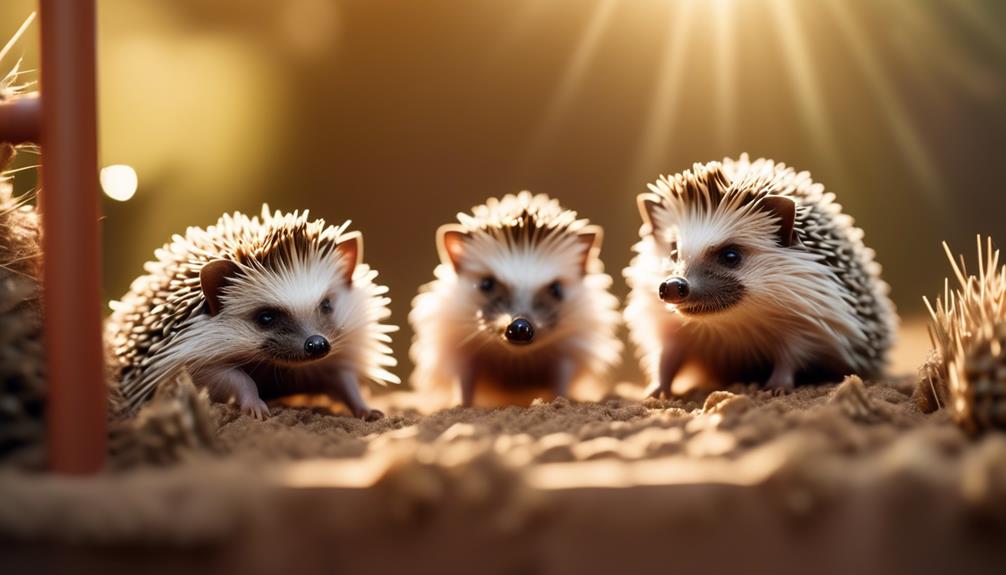
To establish a bond with African Pygmy Hedgehogs, pet owners must prioritize socialization from an early age. These adorable creatures may be shy and reserved, but with proper socialization, they can become friendly and affectionate companions. Socializing with African Pygmy Hedgehogs involves exposing them to different people, sounds, and environments to help them become comfortable and confident. It is crucial to handle them gently and consistently to build trust and prevent fear or aggression. Additionally, providing interactive toys and activities can stimulate their minds and keep them engaged. Here is a table highlighting some key tips for socializing African Pygmy Hedgehogs:
| Socialization Tips | Benefits |
|---|---|
| Regular handling | Builds trust and familiarity |
| Exposure to various sounds | Helps them adapt to noises |
| Introduce new people | Expands their social circle |
| Provide interactive toys | Keeps them mentally stimulated |
| Gradual exposure to new environments | Reduces anxiety and fear |
Training and Handling Hedgehogs
Training and handling hedgehogs requires patience, consistency, and a gentle approach to ensure their comfort and cooperation. These adorable pets can be trained to walk on a leash and enjoy being handled, but it is important to remember that they are shy animals and not as outgoing as rodents.
Here are some tips for training and handling hedgehogs:
- Start with short handling sessions: Begin by slowly introducing your hedgehog to being handled for short periods of time. Gradually increase the duration as they become more comfortable.
- Use positive reinforcement: Reward your hedgehog with treats or praise when they exhibit desired behaviors during handling sessions. This will help to reinforce positive associations.
- Handle them gently: Hedgehogs have sensitive skin and can easily become stressed or injured. Always handle them with care, supporting their body and avoiding sudden movements.
- Be patient: Hedgehogs may take some time to warm up to being handled. Respect their boundaries and give them time to adjust to the new experiences.
Unveiling Additional Facts About Hedgehogs
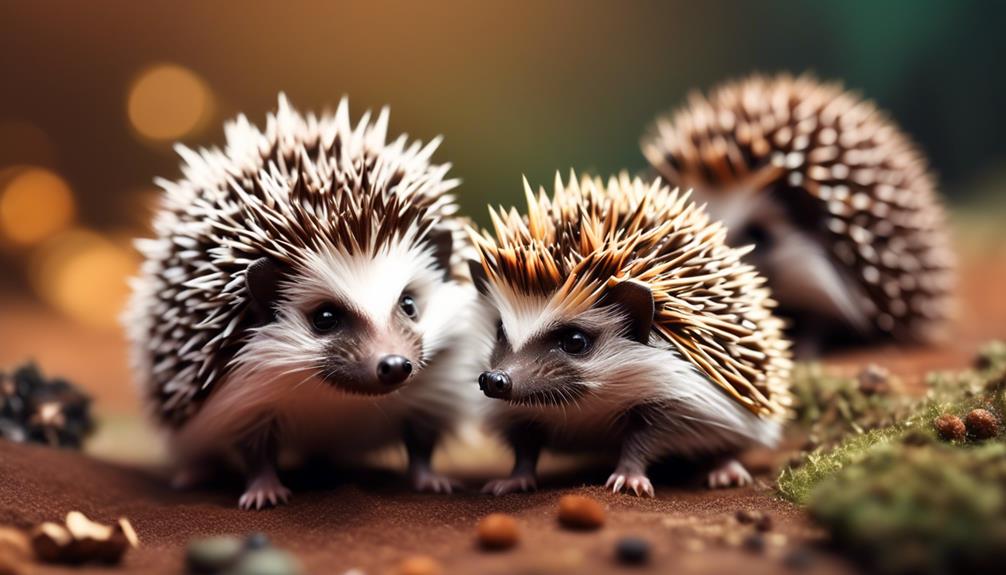
Hedgehogs possess a variety of fascinating characteristics that make them unique among other animals. Besides their adorable appearance and prickly spines, there are several additional facts about hedgehogs that are worth unveiling.
Firstly, it is important to note that hedgehogs are not rodents, but rather belong to their own family. Furthermore, African pygmy hedgehogs, the most common species kept as pets, are actually hybrids of two different species.
The spikes on hedgehogs, commonly referred to as quills or spines, are made of keratin and are modified hairs. Unlike porcupine quills, hedgehog quills are not barbed or easily detachable. These quills are controlled by back muscles and serve as a defense mechanism when the hedgehog feels threatened.
African Pygmy Hedgehog Habitat and Care
A crucial aspect of providing optimal care for African Pygmy Hedgehogs is creating an appropriate habitat that meets their specific needs and requirements. To ensure their well-being and happiness, consider the following:
- Enclosure: Provide a spacious enclosure with plenty of room for them to explore and exercise. A minimum size of 4 square feet is recommended.
- Temperature and Lighting: Maintain a temperature range of 70-80°F (21-27°C) and provide a heat source such as a ceramic heat emitter. Use a full-spectrum light to mimic natural daylight.
- Bedding: Choose a safe bedding material such as paper-based or aspen shavings, avoiding cedar or pine due to their potential harm to hedgehog respiratory systems.
- Enrichment: Offer a variety of hiding spots, tunnels, and toys to keep them mentally stimulated and entertained.
The Growing Popularity of Hedgehog Ownership
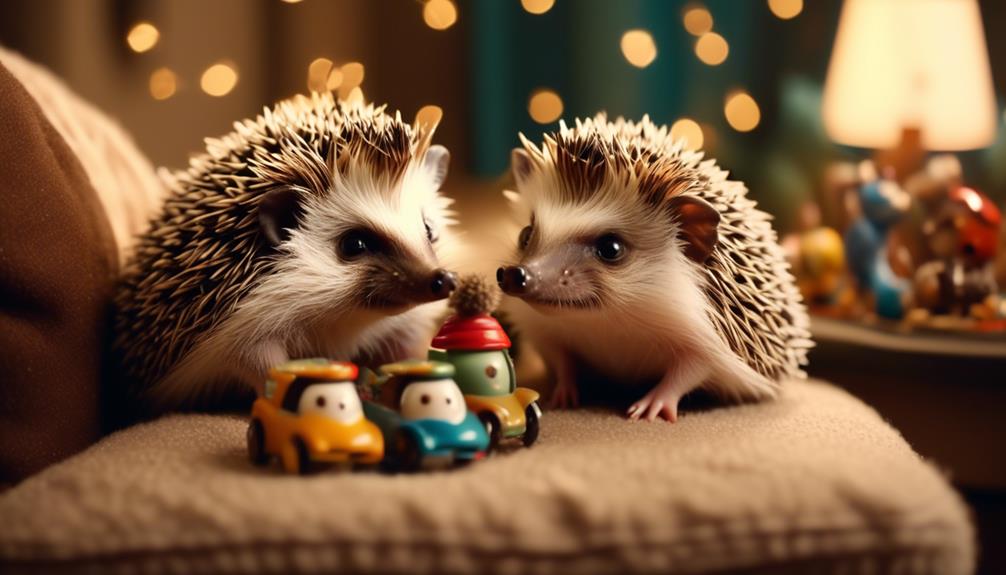
The ownership of hedgehogs has been steadily increasing in popularity in recent years. More and more people are discovering the charm and unique characteristics of these adorable creatures, leading to a surge in hedgehog ownership. The reasons behind this growing trend are varied, but one factor is the increasing availability of African Pygmy Hedgehogs as pets. These small and low-maintenance animals have captured the hearts of many, making them an attractive choice for individuals seeking a unique and fascinating pet.
To further understand the rising popularity of hedgehog ownership, let’s take a look at some key factors:
| Factors | Reasons |
|---|---|
| Distinctive Appearance | Hedgehogs have an irresistibly cute and prickly appearance that appeals to many pet owners. Their tiny size, adorable face, and quills make them visually appealing. |
| Low Maintenance | Hedgehogs are relatively low-maintenance pets, requiring minimal grooming and space. They are independent animals that do not require constant attention. |
| Unique Personality | Although shy initially, hedgehogs can develop a bond with their owners over time. They exhibit interesting behaviors and can be trained to walk on a leash. |
| Social Media Influence | The rise of social media platforms has contributed to the popularity of hedgehogs as pets. Cute hedgehog pictures and videos go viral, capturing the attention of a wide audience. |
| Educational Value | Hedgehogs offer educational opportunities for both adults and children. Owning a hedgehog allows individuals to learn about their natural habitat, behaviors, and care requirements. |
The increasing popularity of hedgehog ownership is a testament to the appeal and unique qualities of these fascinating creatures. As more people discover the joy of having a hedgehog as a pet, it is important to ensure responsible ownership and proper care for these delightful animals.
Frequently Asked Questions
Are African Pygmy Hedgehogs Suitable Pets for Children?
African pygmy hedgehogs can make suitable pets for children under proper supervision and guidance. However, it is important to note that hedgehogs have specific care requirements and may not be as interactive or outgoing as other pets.
What Is the Lifespan of an African Pygmy Hedgehog?
The lifespan of an African Pygmy Hedgehog varies, but on average they live between 4 to 6 years in captivity. Proper care, diet, and a stress-free environment can contribute to a hedgehog’s longevity.
Can African Pygmy Hedgehogs Be Litter Trained?
African Pygmy Hedgehogs can be litter trained with patience and consistency. By providing a specific area with a litter box and using appropriate bedding, hedgehogs can learn to use the designated area for their bathroom needs.
Do African Pygmy Hedgehogs Require Special Heating or Lighting in Their Habitat?
African pygmy hedgehogs require special heating and lighting in their habitat to maintain their optimal temperature and light cycle. This includes providing a heat source, such as a ceramic heat emitter, and a UVB light to mimic natural sunlight.
Are African Pygmy Hedgehogs Legal to Own as Pets in All Countries?
The legality of owning African Pygmy Hedgehogs as pets varies by country. While they are legal in many countries, it is important to research and understand the regulations and requirements in your specific location before acquiring one as a pet.
Are African Pygmy Hedgehogs and Smiley-Faced Egyptian Hedgehogs Similar in Terms of Care and Maintenance?
African Pygmy Hedgehogs and smileyfaced egyptian hedgehogs pets share many care requirements. Both need a warm environment, a varied diet, and gentle handling. Enclosure upkeep, health monitoring, and bonding time are equally essential in nurturing these nocturnal creatures, ensuring their well-being and happiness in a domestic setting.
Conclusion
In conclusion, African Pygmy Hedgehogs are captivating pets with their unique characteristics and intriguing behaviors. Their defense mechanisms, such as raising their spines and rolling into a prickly ball, make them fascinating creatures to observe.
Additionally, their mating behavior adds to their allure. As their popularity as pets continues to grow, it is important to understand the proper care and socialization needed to ensure their well-being.
African Pygmy Hedgehogs truly are adorable companions that have taken the world by storm.

